Top 10 Animals with the Most Extraterrestrial Appearance
The Top Ten
1 Axolotl
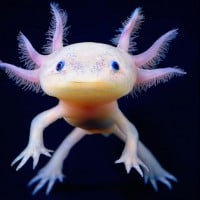 The axolotl, Ambystoma mexicanum, also known as the Mexican walking fish, is a neotenic salamander related to the tiger salamander. Although the axolotl is colloquially known as a "walking fish", it is not a fish, but an amphibian. The axolotl is only native to Lake Xochimilco and Lake Chalco in Mexico. Axolotls in the wild are mostly grassy brown or black, but in captivity, they can even glow in blue light.
The axolotl, Ambystoma mexicanum, also known as the Mexican walking fish, is a neotenic salamander related to the tiger salamander. Although the axolotl is colloquially known as a "walking fish", it is not a fish, but an amphibian. The axolotl is only native to Lake Xochimilco and Lake Chalco in Mexico. Axolotls in the wild are mostly grassy brown or black, but in captivity, they can even glow in blue light.
 The axolotl, Ambystoma mexicanum, also known as the Mexican walking fish, is a neotenic salamander related to the tiger salamander. Although the axolotl is colloquially known as a "walking fish", it is not a fish, but an amphibian. The axolotl is only native to Lake Xochimilco and Lake Chalco in Mexico. Axolotls in the wild are mostly grassy brown or black, but in captivity, they can even glow in blue light.
The axolotl, Ambystoma mexicanum, also known as the Mexican walking fish, is a neotenic salamander related to the tiger salamander. Although the axolotl is colloquially known as a "walking fish", it is not a fish, but an amphibian. The axolotl is only native to Lake Xochimilco and Lake Chalco in Mexico. Axolotls in the wild are mostly grassy brown or black, but in captivity, they can even glow in blue light.
2 Gulper Eel
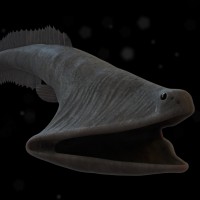

3 Dumbo Octopus
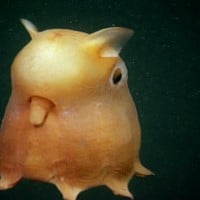 Dumbo Octopus (Grimpoteuthis) is a small deep sea animal that dwells on the ocean floor at the depths of 9,800 to 13,000 feet. They are the deepest living octopuses known. It was named from a 1941 Disney film Dumbo.
Dumbo Octopus (Grimpoteuthis) is a small deep sea animal that dwells on the ocean floor at the depths of 9,800 to 13,000 feet. They are the deepest living octopuses known. It was named from a 1941 Disney film Dumbo.
 Dumbo Octopus (Grimpoteuthis) is a small deep sea animal that dwells on the ocean floor at the depths of 9,800 to 13,000 feet. They are the deepest living octopuses known. It was named from a 1941 Disney film Dumbo.
Dumbo Octopus (Grimpoteuthis) is a small deep sea animal that dwells on the ocean floor at the depths of 9,800 to 13,000 feet. They are the deepest living octopuses known. It was named from a 1941 Disney film Dumbo.
4 Sea Pig
 Scotoplanes, commonly known as the sea pig, is a genus of deep-sea holothurian echinoderm of the family Elpidiidae, order Elasipodida.
Scotoplanes, commonly known as the sea pig, is a genus of deep-sea holothurian echinoderm of the family Elpidiidae, order Elasipodida.
 Scotoplanes, commonly known as the sea pig, is a genus of deep-sea holothurian echinoderm of the family Elpidiidae, order Elasipodida.
Scotoplanes, commonly known as the sea pig, is a genus of deep-sea holothurian echinoderm of the family Elpidiidae, order Elasipodida.
5 Starfish


6 Star-Nosed Mole
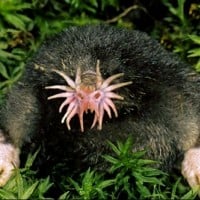 The star-nosed mole is a small mole found in wet low areas in the northern parts of North America. It is the only member of the tribe Condylurini and the genus Condylura.
The star-nosed mole is a small mole found in wet low areas in the northern parts of North America. It is the only member of the tribe Condylurini and the genus Condylura.
 The star-nosed mole is a small mole found in wet low areas in the northern parts of North America. It is the only member of the tribe Condylurini and the genus Condylura.
The star-nosed mole is a small mole found in wet low areas in the northern parts of North America. It is the only member of the tribe Condylurini and the genus Condylura.
7 Hammerhead Shark
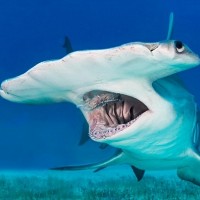

8 Lamprey
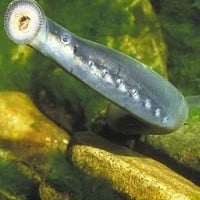 Lampreys (also known as sea lampreys) are primitive parasites that feed off other organisms. Inside their tubular mouths are razor-sharp teeth, arranged in circular rows, which work like a can opener. By boring a hole in their victim's flesh, the lamprey is able to expose the raw and bloody muscle beneath. ...read more.
Lampreys (also known as sea lampreys) are primitive parasites that feed off other organisms. Inside their tubular mouths are razor-sharp teeth, arranged in circular rows, which work like a can opener. By boring a hole in their victim's flesh, the lamprey is able to expose the raw and bloody muscle beneath. ...read more.
 Lampreys (also known as sea lampreys) are primitive parasites that feed off other organisms. Inside their tubular mouths are razor-sharp teeth, arranged in circular rows, which work like a can opener. By boring a hole in their victim's flesh, the lamprey is able to expose the raw and bloody muscle beneath. ...read more.
Lampreys (also known as sea lampreys) are primitive parasites that feed off other organisms. Inside their tubular mouths are razor-sharp teeth, arranged in circular rows, which work like a can opener. By boring a hole in their victim's flesh, the lamprey is able to expose the raw and bloody muscle beneath. ...read more.
9 Mantis Shrimp
 The mantis shrimp, or stomatopod, is a type of marine crustacean of the order Stomatopoda. Most species can grow to around 10 centimetres in length, though a few species reach up to 38 cm.
The mantis shrimp, or stomatopod, is a type of marine crustacean of the order Stomatopoda. Most species can grow to around 10 centimetres in length, though a few species reach up to 38 cm.
 The mantis shrimp, or stomatopod, is a type of marine crustacean of the order Stomatopoda. Most species can grow to around 10 centimetres in length, though a few species reach up to 38 cm.
The mantis shrimp, or stomatopod, is a type of marine crustacean of the order Stomatopoda. Most species can grow to around 10 centimetres in length, though a few species reach up to 38 cm. Those alien eyes like headlights...
10 Umbonia Spinosa
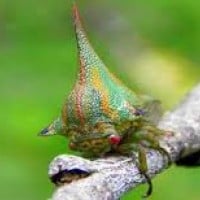

The Contenders
11 Peacock Spider
12 Mimic Octopus
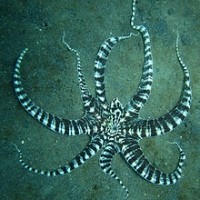 The mimic octopus is an Indo-Pacific species of octopus capable of impersonating other local species.
The mimic octopus is an Indo-Pacific species of octopus capable of impersonating other local species.
 The mimic octopus is an Indo-Pacific species of octopus capable of impersonating other local species.
The mimic octopus is an Indo-Pacific species of octopus capable of impersonating other local species.
13 Chameleon
 Chameleons or chamaeleons are a distinctive and highly specialized clade of old world lizards with 202 species described as of June 2015. These species come in a range of colors, and many species have the ability to change colors.
Chameleons or chamaeleons are a distinctive and highly specialized clade of old world lizards with 202 species described as of June 2015. These species come in a range of colors, and many species have the ability to change colors.
 Chameleons or chamaeleons are a distinctive and highly specialized clade of old world lizards with 202 species described as of June 2015. These species come in a range of colors, and many species have the ability to change colors.
Chameleons or chamaeleons are a distinctive and highly specialized clade of old world lizards with 202 species described as of June 2015. These species come in a range of colors, and many species have the ability to change colors.
14 Flies
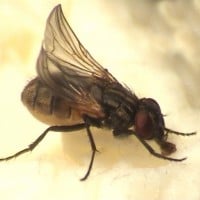

15 Dog
 The dog or domestic dog (Canis familiaris or Canis lupus familiaris) is a domesticated descendant of the wolf, and is characterized by an upturning tail. The dog is derived from an ancient, extinct wolf, and the modern wolf is the dog's nearest living relative. The dog was the first species to be domesticated, by hunter–gatherers over 15,000 years ago, before the development of agriculture. Due to their long association with humans, dogs have expanded to a large number of domestic individuals and gained the ability to thrive on a starch-rich diet that would be inadequate for other canids. ...read more.
The dog or domestic dog (Canis familiaris or Canis lupus familiaris) is a domesticated descendant of the wolf, and is characterized by an upturning tail. The dog is derived from an ancient, extinct wolf, and the modern wolf is the dog's nearest living relative. The dog was the first species to be domesticated, by hunter–gatherers over 15,000 years ago, before the development of agriculture. Due to their long association with humans, dogs have expanded to a large number of domestic individuals and gained the ability to thrive on a starch-rich diet that would be inadequate for other canids. ...read more.
 The dog or domestic dog (Canis familiaris or Canis lupus familiaris) is a domesticated descendant of the wolf, and is characterized by an upturning tail. The dog is derived from an ancient, extinct wolf, and the modern wolf is the dog's nearest living relative. The dog was the first species to be domesticated, by hunter–gatherers over 15,000 years ago, before the development of agriculture. Due to their long association with humans, dogs have expanded to a large number of domestic individuals and gained the ability to thrive on a starch-rich diet that would be inadequate for other canids. ...read more.
The dog or domestic dog (Canis familiaris or Canis lupus familiaris) is a domesticated descendant of the wolf, and is characterized by an upturning tail. The dog is derived from an ancient, extinct wolf, and the modern wolf is the dog's nearest living relative. The dog was the first species to be domesticated, by hunter–gatherers over 15,000 years ago, before the development of agriculture. Due to their long association with humans, dogs have expanded to a large number of domestic individuals and gained the ability to thrive on a starch-rich diet that would be inadequate for other canids. ...read more.
16 Pigbutt Worm
17 Jellyfish
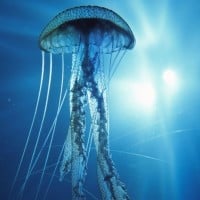

18 Naked Mole Rat
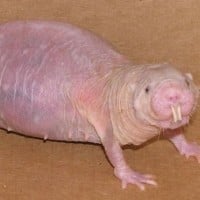 The naked mole-rat, also known as the sand puppy, is a burrowing rodent native to parts of East Africa. It is closely related to the blesmols and is the only species in the genus Heterocephalus of the family Heterocephalidae.
The naked mole-rat, also known as the sand puppy, is a burrowing rodent native to parts of East Africa. It is closely related to the blesmols and is the only species in the genus Heterocephalus of the family Heterocephalidae.
 The naked mole-rat, also known as the sand puppy, is a burrowing rodent native to parts of East Africa. It is closely related to the blesmols and is the only species in the genus Heterocephalus of the family Heterocephalidae.
The naked mole-rat, also known as the sand puppy, is a burrowing rodent native to parts of East Africa. It is closely related to the blesmols and is the only species in the genus Heterocephalus of the family Heterocephalidae.
19 Scallops
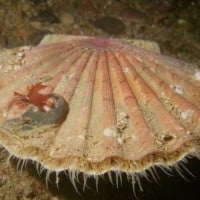

20 Snake
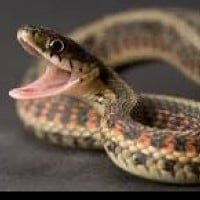 Snakes are elongated, legless, carnivorous reptiles of the suborder Serpentes that can be distinguished from legless lizards by their lack of eyelids and external ears.
Snakes are elongated, legless, carnivorous reptiles of the suborder Serpentes that can be distinguished from legless lizards by their lack of eyelids and external ears.
 Snakes are elongated, legless, carnivorous reptiles of the suborder Serpentes that can be distinguished from legless lizards by their lack of eyelids and external ears.
Snakes are elongated, legless, carnivorous reptiles of the suborder Serpentes that can be distinguished from legless lizards by their lack of eyelids and external ears.
21 Waterbear
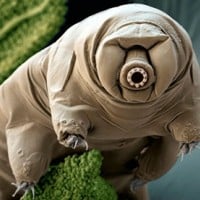 The waterbear, or also known as the tardigrade or moss piglet, is a water-dwelling eight-legged micro animals. The waterbear is known for being the most resilient animal: It can survive very hot and very cold temperatures, pressures about 6 times greater than the pressure in deep-seas, radiations at ...read more.
The waterbear, or also known as the tardigrade or moss piglet, is a water-dwelling eight-legged micro animals. The waterbear is known for being the most resilient animal: It can survive very hot and very cold temperatures, pressures about 6 times greater than the pressure in deep-seas, radiations at ...read more.
 The waterbear, or also known as the tardigrade or moss piglet, is a water-dwelling eight-legged micro animals. The waterbear is known for being the most resilient animal: It can survive very hot and very cold temperatures, pressures about 6 times greater than the pressure in deep-seas, radiations at ...read more.
The waterbear, or also known as the tardigrade or moss piglet, is a water-dwelling eight-legged micro animals. The waterbear is known for being the most resilient animal: It can survive very hot and very cold temperatures, pressures about 6 times greater than the pressure in deep-seas, radiations at ...read more.
22 Blobfish
 The blobfish is a deep sea fish of the family Psychrolutidae. It inhabits the deep waters off the coasts of mainland Australia and Tasmania, as well as the waters of New Zealand.
The blobfish is a deep sea fish of the family Psychrolutidae. It inhabits the deep waters off the coasts of mainland Australia and Tasmania, as well as the waters of New Zealand.
 The blobfish is a deep sea fish of the family Psychrolutidae. It inhabits the deep waters off the coasts of mainland Australia and Tasmania, as well as the waters of New Zealand.
The blobfish is a deep sea fish of the family Psychrolutidae. It inhabits the deep waters off the coasts of mainland Australia and Tasmania, as well as the waters of New Zealand.
23 Squid
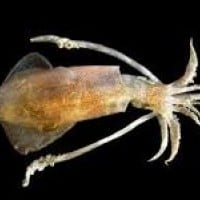 Squid are cephalopods of the order Teuthida, which comprises around 304 species. Like all other cephalopods, squid have a distinct head, bilateral symmetry, a mantle, and arms.
Squid are cephalopods of the order Teuthida, which comprises around 304 species. Like all other cephalopods, squid have a distinct head, bilateral symmetry, a mantle, and arms.
 Squid are cephalopods of the order Teuthida, which comprises around 304 species. Like all other cephalopods, squid have a distinct head, bilateral symmetry, a mantle, and arms.
Squid are cephalopods of the order Teuthida, which comprises around 304 species. Like all other cephalopods, squid have a distinct head, bilateral symmetry, a mantle, and arms.
24 Spiders
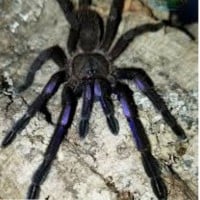

25 Octopus
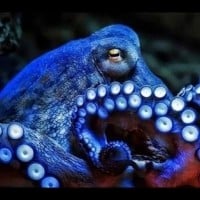 An octopus (octopuses or octopodes, see below for variants) is a soft-bodied, eight-limbed mollusc of the order Octopoda. The order consists of some 300 species and is grouped within the class Cephalopoda with squids, cuttlefish, and nautiloids. Like other cephalopods, an octopus is bilaterally symmetric ...read more.
An octopus (octopuses or octopodes, see below for variants) is a soft-bodied, eight-limbed mollusc of the order Octopoda. The order consists of some 300 species and is grouped within the class Cephalopoda with squids, cuttlefish, and nautiloids. Like other cephalopods, an octopus is bilaterally symmetric ...read more.
 An octopus (octopuses or octopodes, see below for variants) is a soft-bodied, eight-limbed mollusc of the order Octopoda. The order consists of some 300 species and is grouped within the class Cephalopoda with squids, cuttlefish, and nautiloids. Like other cephalopods, an octopus is bilaterally symmetric ...read more.
An octopus (octopuses or octopodes, see below for variants) is a soft-bodied, eight-limbed mollusc of the order Octopoda. The order consists of some 300 species and is grouped within the class Cephalopoda with squids, cuttlefish, and nautiloids. Like other cephalopods, an octopus is bilaterally symmetric ...read more.8Load More
PSearch List